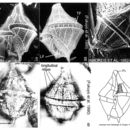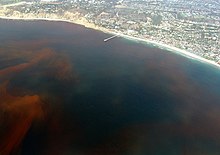mk
имиња во трошки


Gonyaulax ist eine Gattung von Dinoflagellaten mit der Typusart Gonyaulax spinifera. Die Gonyaulax-Arten sondern eine Reihe von Toxinen (Giftstoffen) ab, aufgrund ihrer roten Pigmentierung (Färbung) werden die von ihnen verursachten schädlichen Algenblüten (englisch harmful algal blooms, HABs) auch Rote Tiden (en. red tides) genannt.[1]
Alle Gonyaulax-Arten sind marin, mit Ausnahme der Süßwasserart G. apiculata [2] (alias G. clevei [3]).
Zumindest einige Gonyaulax-Arten (darunter die Typusart G. spinifera) sind biolumineszent.[3]
Einige Arten sind mixotroph und nehmen Beuteorganismen auf.[3]
Alle Gonyaulax-Arten sind aquatisch lebende, 25–175 µm große Einzeller. Sie sind – bis auf Ruhestadien s. u. – motil (beweglich): Sie sind mit zwei unterschiedlichen Geißeln ausgestattet („heterodynamisch“); die eine erstreckt sich nach hinten und die andere wickelt sich in einer seitlichen Rille um die Zelle und hilft so, diese durch Rotationsbewegung über Wasser zu halten.[4] Sie besitzen eine Zellwand (Theca) aus Zelluloseplatten. Die Plattenformel der Typusart G. spinifera ist
Die Plattenformel in der Gattung Gonyaulax wurde von Dodge 1989 neu definiert als Po, 3', 2a, 6", 6c, 4-8s, 5'", 1p, 1".[2][5] Die Interpretation des Plattenaufbaus der verschiedenen Gonyaulax-Arten war danach aber weiter in der Diskussion,[5][3] einige Arten haben offenbar tatsächlich davon abweichende Plattenstruktur, so dass diese nur für die Typusart G. spinifera und ähnliche Arten der Gattung gelten kann.[3]
Bei der Typusart und ihr ähnlichen zeigen die Zellen eine deutliche Asymmetrie, d. h. Verdrehung (Torsion). Das Cingulum beginnt median ventral und dreht sich in einer absteigenden Spirale nach links, wobei es mehr als eine Schleife bildet. Der Sulcus ist (beginnend am mittig-ventral am Cingulum) entsprechend nach hinten verdreht. Auf den Platten der Hypotheca befinden sich wenige bis mäßig viele Stacheln.[3]
Bei diesen Arten gibt es einen mehrlappigen Chloroplasten, der in einen zentralen Pyrenoidkomplex ohne Stärkeschicht übergeht. Der große Zellkern ist U-förmig und befindet sich am dorsalen hinteren Ende der Zelle. Die Trichozysten werden in den Vesikeln des Golgi-Apparats gebildet. Der Geißelapparat ist komplex und ähnelt dem anderer Arten aus der Ordnung bzw. Familie.[3]
Etliche Arten mit unterschiedlicher Morphologie wurden ebenfalls zu Gonyaulax gezählt, wie z. B. G. polyedra, werden heute aber mehr und mehr anderen Arten zugeordnet (s. u.).
Die vegetative Vermehrung erfolgt durch Spaltung in zwei Tochterzellen (binäre Spaltung), wobei die Theca (Panzerung) der Mutterzelle entlang einer charakteristischen Spaltlinie geteilt wird und auf die beiden Tochterzellen aufgeteilt wird.[3] Gonyaulax können in langen Ketten wachsen, vor allem bei turbulenten Wasserverhältnissen. Diese Ketten ermöglichen den Schutz schwacher Organismen, die sonst weggespült werden könnten, und ermöglichen eine verstärkte Paarung.[6]
Gonyaulax-Dinoflagellaten können eine Art von Ruhespore (oder Ruhezyste) bilden, die es ihnen ermöglicht, raue Wetterbedingungen zu überleben. Ruhezysten können gebildet werden, wenn sich die Temperatur oder der Salzgehalt des umgebenden Wassers ändert. Diese Zysten sind runde, mit Schleim bedeckte Körper, die eine rötliche Farbe haben.[6] Nachweislich produzieren Zysten unterschiedlicher Morphologie, die deswegen verschiedenen (Zysten-)Gattungen zugeordnet wurden, vegetative Zellen, die als die Typusart G. spinifera identifiziert wurden (Beispiele finden sich bei AlgaeBase).[3]
Die hier angegebene Artenliste mit Stand 28. Dezember 2021 folgt im Wesentlichen der AlgaeBase,[3] führt aber nur Arten, die dort als bestätigt markiert sind. Mit (N) gekennzeichnete Einträge sind auch beim National Center for Biotechnology Information (NCBI)[7] gelistet. Alle Einträge finden sich auch bei der World Register of Marine Species (WoRMS),[8] außer sie sind mit (-W) markiert. Auf fossile Spezies wird wie üblich mit † hingewiesen.
Gattung Gonyaulax Diesing, 1866 (N). Arten:
In andere Gattungen verschoben wurden u. a. folgende früher hier geführte Spezies:[2][3]
Bei den Roten Tiden handelt es sich um eine Verfärbung des Meerwassers durch pigmentierte Zellen wie Gonyaulax spp., von denen einige Toxine produzieren können. Einige Gonyaulax-Arten sondern ein giftiges Toxin namens Gonyautoxin (GTX, aus der Gruppe der Saxitoxine) ab, das beim Menschen Lähmungen verursacht.[1][12][13] Gonyaulax spinifera wird mit der Produktion von Yessotoxinen (YTX) in Verbindung gebracht, einer Gruppe strukturell verwandter Polyethertoxine mit strickleiterartigem Aufbau, die sich in Muscheln ansammeln und ähnliche Symptome hervorrufen können wie die Toxine der Paralytischen Muschelvergiftung (en. paralytic shellfish poisoning, PSP).[14]
Obwohl Gonyaulax vor allem im Meerwasser vorkommt, kann es auch für den Menschen schädliche Auswirkungen haben. Filterfressende Organismen (z. B. Miesmuscheln, Venusmuscheln usw.) können diese Dinoflagellaten in ihrem Körper ansammeln. Diese Anreicherung von Dinoflagellaten geschieht während der Gezeiten Ebbe und Flut, in der Regel in den wärmeren Monaten des Jahres. Wenn der Mensch diese Muscheln dann isst, kann es zu Vergiftungen führen.[4]
Gonyaulax ist eine Gattung von Dinoflagellaten mit der Typusart Gonyaulax spinifera. Die Gonyaulax-Arten sondern eine Reihe von Toxinen (Giftstoffen) ab, aufgrund ihrer roten Pigmentierung (Färbung) werden die von ihnen verursachten schädlichen Algenblüten (englisch harmful algal blooms, HABs) auch Rote Tiden (en. red tides) genannt.
Alle Gonyaulax-Arten sind marin, mit Ausnahme der Süßwasserart G. apiculata (alias G. clevei ).
Gonyaulax is a genus of dinoflagellates with the type species Gonyaulax spinifera (Claparède et Lachmann) Diesing. Gonyaulax belongs to red dinoflagellates and commonly causes red tides. It secretes a poisonous toxin known as "saxitoxin" which causes paralysis in humans.[4]
Gonyaulax is a genus of dinoflagellates that are aquatic organisms with two separate flagella: one extends backward and the other wraps around the cell in a lateral groove helping to keep the organism afloat by rotational motility.[5] The plate formula in the genus Gonyaulax Diesing was redefined as Po, 3', 2a, 6", 6c, 4-8s, 5'", 1p, 1"".[6]
All species are marine, except for one freshwater species, Gonyaulax apiculata.[6]
It previously included several species, which are now considered to belong to a separate genus, e.g.:[6]
Gonyaulax dinoflagellates have evolved a type of resting spore (or resting cyst), to enable it to survive harsh weather conditions. Resting cysts can be formed when temperature or salinity changes in the surrounding water. These cysts are round mucous covered bodies that appear reddish in color. Gonyaulax catenella has been recorded forming vegetative cysts in response to cold water.[7]
Gonyaulax are protists that may grow in long chains, especially when faced with turbulent water conditions. These chains allow for clustering of organisms for increased mating, and protection of weakly swimming organisms that could otherwise be washed away.[7]
Although Gonyaulax is predominantly found in seawater, it can also have a detrimental effect on humans. Filter feeding organisms (e.g. mussels, clams, etc.) can accumulate these dinoflagellates in their bodies. When humans eat these shellfish after dinoflagellate accumulation during Red Tide season, usually during the warmer months of the year, it can poison the person who eats it.[5]
Red tide is a discoloration of the sea water by pigmented cells like Gonyaulax spp., some of which may produce toxins. Gonyaulax spinifera has been connected to the production of yessotoxins (YTXs), a group of structurally related polyether toxins, which can accumulate in shellfish and produce symptoms similar to those produced by paralytic shellfish poisoning (PSP) toxins.[8]
 Red tide off the coast of La Jolla, California.
Red tide off the coast of La Jolla, California. Gonyaulax is a genus of dinoflagellates with the type species Gonyaulax spinifera (Claparède et Lachmann) Diesing. Gonyaulax belongs to red dinoflagellates and commonly causes red tides. It secretes a poisonous toxin known as "saxitoxin" which causes paralysis in humans.